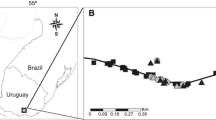Abstract
Evidence of natural hybridization betweenArctostaphylos viscida andA. canescens in southwestern Oregon was obtained from morphological studies of field populations. Hybridization occurs where populations ofA. viscida andA. canescens meet in areas where serpentine and nonserpentine soils abut. At these contacts,A. viscida forms large populations only on serpentine andA. canescens only on nonserpentine. Most of the indentifiable hybrids survive on either transitional or nonserpentine soils. The small proportion that are found on serpentine are considered to be backcrosses toA. viscida. The hybrid plants are similar to several putative species maintained in the standard floras, and it is suggested that these no longer be given taxonomic recognition.
Similar content being viewed by others
Literature Cited
Abrams, L. 1951. Illustrated Flora of the Pacific States, Washington, Oregon, and California. Vol. 3. Stanford, California: Stanford Univ. Press, viii + 866 pp.
Adams, J. E. 1940. A systematic study of the genusArctostaphylos Adans. Jour. Elisha Mitchell Sci. Soc.56: 1–62.
Anderson, E. 1948. Hybridization of the habitat. Evolution2: 1–9.
— 1949. Introgressive Hybridization. New York: John Wiley & Sons, ix + 109 pp.
— 1951. Concordant versus discordant variation in relation to introgression. Evolution5: 133–141.
Benson, G. T. 1930. The Trees and Shrubs of Western Oregon. Contr. Dudley Herb.2: 1–170.
Epling, C. 1947. The genetic aspects of nature populations. Actual and potential gene flow in natural populations. Amer. Nat.81(797): 104–113.
Howell, T. 1901. A Flora of Northwest America. Vol. I. Phanerogamae. Portland, Oregon. 792 pp.
Jepson, W. L. 1939. A Flora of California. Vol. 3(1). Berkeley: Univ. California Press. 128 pp.
Mun, P. A. 1959. A California Flora. Berkeley & Los Angeles: Univ. California Press. 1681 pp.
Nobs, M. A. 1963. Experimental studies on species relationships inCeanothus. Carnegie Inst. Washington Publ. 623. 94 pp.
Peck, M. E. 1961. A Manual of the Higher Plants of Oregon. 2nd ed. Portland, Oregon: Binfords & Mort. 936 pp.
Shenon, P. J. 1933. Geology and ore deposits of the Takilma-Waldo District, Oregon, including the Blue Creek District. U. S. Geol. Surv. Bull.846(B):141–194.
Walker, R. B. 1954. The ecology of serpentine soils. II. Factors affecting plant growth on serpentine soils. Ecology35: 259–266.
Wells, F. G., P. E. Hotz, &F. W. Cater, Jr. 1949. Preliminary description of the geology of the Kerby Quadrangle, Oregon. Oregon Dept. Geol. & Mineral Indust. Bull.40: 1–23.
Whittaker, R. H. 1960. Vegetation of the Siskiyou Mountains, Oregon and California. Ecol. Monogr.30: 279–338.
Author information
Authors and Affiliations
Additional information
Based on a thesis submitted to Oregon State University in partial fulfillment of the requirements for the M.S. degree.
This work was done in the Department of Botany, Oregon State University, Corvallis.
Rights and permissions
About this article
Cite this article
Gottlieb, L.D. Hybridization between Arctostaphylos viscida and A. canescens in Oregon. Brittonia 20, 83–93 (1968). https://doi.org/10.2307/2805463
Issue Date:
DOI: https://doi.org/10.2307/2805463




